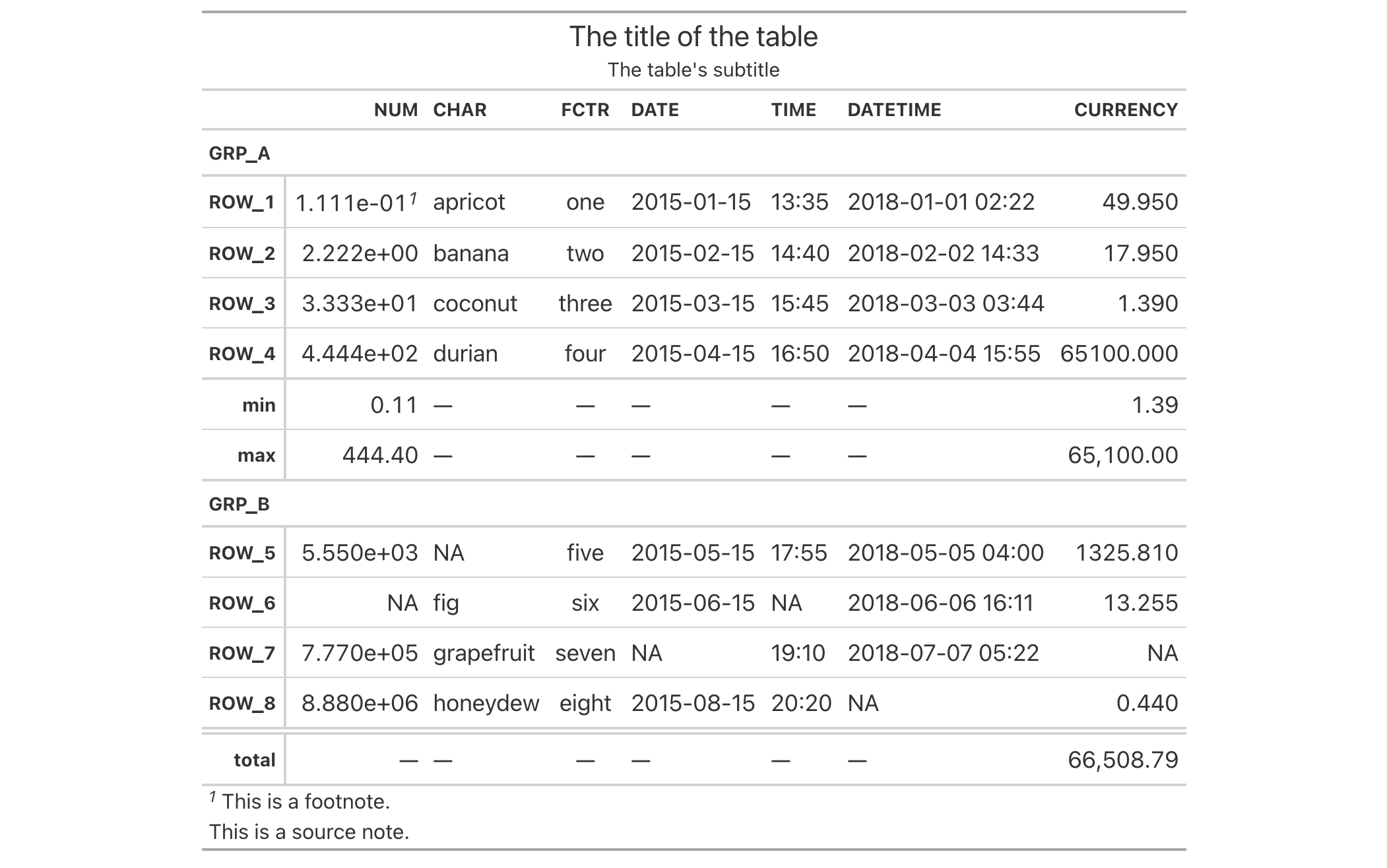opt_all_caps: Option to use all caps in select table locations
In gt: Easily Create Presentation-Ready Display Tables
opt_all_caps R Documentation
Option to use all caps in select table locations
Description
Sometimes an all-capitalized look is suitable for a table. With the
opt_all_caps() function, we can transform characters in the column labels,
the stub, and in all row groups in this way (and there's control over which
of these locations are transformed).
This function serves as a convenient shortcut for <gt_tbl> |> tab_options(<location>.text_transform = "uppercase", <location>.font.size = pct(80), <location>.font.weight = "bolder") (for all locations selected).
Usage
opt_all_caps(
data,
all_caps = TRUE,
locations = c("column_labels", "stub", "row_group")
)
Arguments
data
The gt table data object
obj:<gt_tbl> // required
This is the gt table object that is commonly created through use of the
gt() function.
all_caps
Use all-caps transformation
scalar<logical> // default: TRUE
A logical value to indicate whether the text transformation to all caps
should be performed (TRUE, the default) or reset to default values
(FALSE) for the locations targeted.
locations
Locations to target
mult-kw:[column_labels|stub|row_group] // default: c("column_labels", "stub", "row_group")
Which locations should undergo this text transformation? By default it
includes all of the "column_labels", the "stub", and the "row_group"
locations. However, we could just choose one or two of those.
Value
An object of class gt_tbl.
Examples
Use the exibble dataset to create a gt table with a number of table
parts added (using functions like summary_rows(), grand_summary_rows(),
and more). Following that, we'll ensure that all text in the column labels,
the stub, and in all row groups is transformed to all caps using
opt_all_caps().
exibble |>
gt(rowname_col = "row", groupname_col = "group") |>
summary_rows(
groups = "grp_a",
columns = c(num, currency),
fns = c("min", "max")
) |>
grand_summary_rows(
columns = currency,
fns = total ~ sum(., na.rm = TRUE)
) |>
tab_source_note(source_note = "This is a source note.") |>
tab_footnote(
footnote = "This is a footnote.",
locations = cells_body(columns = 1, rows = 1)
) |>
tab_header(
title = "The title of the table",
subtitle = "The table's subtitle"
) |>
opt_all_caps()

Function ID
10-9
Function Introduced
v0.2.0.5 (March 31, 2020)
See Also
Other table option functions:
opt_align_table_header(),
opt_css(),
opt_footnote_marks(),
opt_footnote_spec(),
opt_horizontal_padding(),
opt_interactive(),
opt_row_striping(),
opt_stylize(),
opt_table_font(),
opt_table_lines(),
opt_table_outline(),
opt_vertical_padding()
gt documentation built on April 12, 2025, 1:26 a.m.
| opt_all_caps | R Documentation |
Option to use all caps in select table locations
Description
Sometimes an all-capitalized look is suitable for a table. With the
opt_all_caps() function, we can transform characters in the column labels,
the stub, and in all row groups in this way (and there's control over which
of these locations are transformed).
This function serves as a convenient shortcut for <gt_tbl> |> tab_options(<location>.text_transform = "uppercase", <location>.font.size = pct(80), <location>.font.weight = "bolder") (for all locations selected).
Usage
opt_all_caps(
data,
all_caps = TRUE,
locations = c("column_labels", "stub", "row_group")
)
Arguments
data |
The gt table data object
This is the gt table object that is commonly created through use of the
|
all_caps |
Use all-caps transformation
A logical value to indicate whether the text transformation to all caps
should be performed ( |
locations |
Locations to target
Which locations should undergo this text transformation? By default it
includes all of the |
Value
An object of class gt_tbl.
Examples
Use the exibble dataset to create a gt table with a number of table
parts added (using functions like summary_rows(), grand_summary_rows(),
and more). Following that, we'll ensure that all text in the column labels,
the stub, and in all row groups is transformed to all caps using
opt_all_caps().
exibble |>
gt(rowname_col = "row", groupname_col = "group") |>
summary_rows(
groups = "grp_a",
columns = c(num, currency),
fns = c("min", "max")
) |>
grand_summary_rows(
columns = currency,
fns = total ~ sum(., na.rm = TRUE)
) |>
tab_source_note(source_note = "This is a source note.") |>
tab_footnote(
footnote = "This is a footnote.",
locations = cells_body(columns = 1, rows = 1)
) |>
tab_header(
title = "The title of the table",
subtitle = "The table's subtitle"
) |>
opt_all_caps()

Function ID
10-9
Function Introduced
v0.2.0.5 (March 31, 2020)
See Also
Other table option functions:
opt_align_table_header(),
opt_css(),
opt_footnote_marks(),
opt_footnote_spec(),
opt_horizontal_padding(),
opt_interactive(),
opt_row_striping(),
opt_stylize(),
opt_table_font(),
opt_table_lines(),
opt_table_outline(),
opt_vertical_padding()
Add the following code to your website.
For more information on customizing the embed code, read Embedding Snippets.
